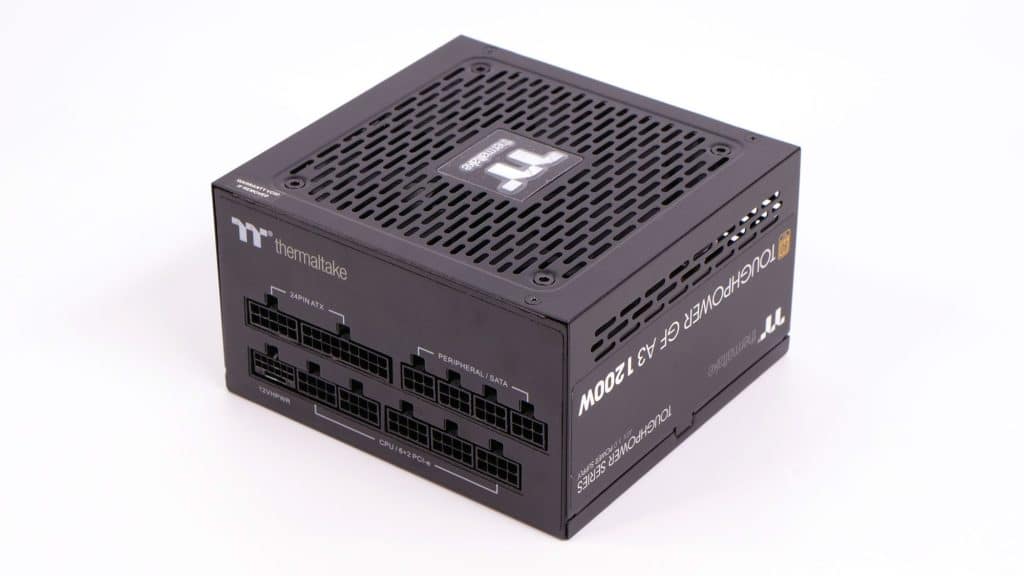Epilogue
Thermaltake switched OEMs and used HKC instead of CWT for the GF A3 line. In overall performance, CWT’s implementation fares better, but it loses in overall noise output. In any case, both GF3 and GF3 A3 1200W units are noisy, and Thermaltake should start taking output noise under serious consideration since the times when users only cared about performance have long gone. The vital assets of the GF3 A3 1200 are the compact dimensions, 20mm less depth than the GF3 1200, the decent overall performance, the ATX v3.0 and PCIe 5.0 compatibility, and the ten-year warranty. The platform also achieves high average efficiency and comes with a 12VHPWR cable with its connector set at 600W.
I cannot say that I am excited with the CapXon caps used everywhere in the unit’s secondary side, but as I hear, Chinese cap factories have nothing to do with the past, producing way better products. After all, this product is covered by a hefty ten-year warranty, meaning Thermaltake has faith in it, or else it wouldn’t offer it. Compared to the CWT-made GF3 1200 model, the GF3 A3 similar capacity model costs around 15 dollars less, and at the same time, it has about 0.9% lower overall performance while it has a slight lead in noise output. However, it is still unsuitable for systems where quiet operation is a priority. I am unsure why TT wanted to create internal competition for its lines since the GF3 and GF3 A3 lines are very close. Probably, it didn’t want to put all of its eggs into a single basket, and this makes sense, especially since CWT’s CSZ platform is widely available in today’s market and used by several big brands. In contrast, HKC’s platform is not so widespread.
The Thermaltake GF A3 1200 needs an improvement in the transient response section, which is of utmost importance. Noise output also has to go lower, especially in mid loads, and efficiency at light loads should be improved since, for prolonged periods, PC systems can be at light utilization, and electricity prices are already through the roof, in Europe at least. Lastly, HKC needs to do something about the high inrush currents, which can create problems to weak electrical infrastructures.
To check all alternative PSU offerings, read my Best ATX v3.0 PSUs article before investing in a new power supply. You help me a lot by using my affiliate links, which don’t increase the product’s price. I get a commission from Amazon every time you do it, which can make a difference for me, especially now that I am on my own, working exclusively for my media and not for someone else.
- Affordable price (given its specifications)
- Delivered full power at 47°C
- Decent overall performance
- High average efficiency (Cybenetics Platinum)
- ATX v3.0 and PCIe 5.0 ready
- Highly efficient 5VSB rail
- Low vampire power
- Tight load regulation on the minor rails
- Good ripple suppression
- Good soldering quality
- Long hold-up time
- Alternative Low Power Mode (ALPM) compatible
- Fully modular
- 12+4 pin PCIe connector (600W)
- Compact dimensions (140mm depth)
- Ideal distance between the peripheral connectors (150-155mm)
- Ten-year warranty
- Mediocre transient response at 12V
- Highly set OCP triggering points on the minor rails (especially 3.3V)
- Noisy operation at mid and high-loads
- High inrush currents
- Efficiency should be higher at light and super-light loads
- PF readings at 230V could be higher




Got the 1200W for around 150$, turned out to be the CE-Link model made in Vietnam. Thank you for informing of these different versions and scummy ass companies. Time to return this piece of shit!
It is not that bad, for 150 dollars, but ok TT should inform users before making this change, that’s for sure.
Its good unit? for 4080super or 4090 with ryzen 5700x3d?
It will be more than enough for this system yes.
thanks! i hope so… bought one today….